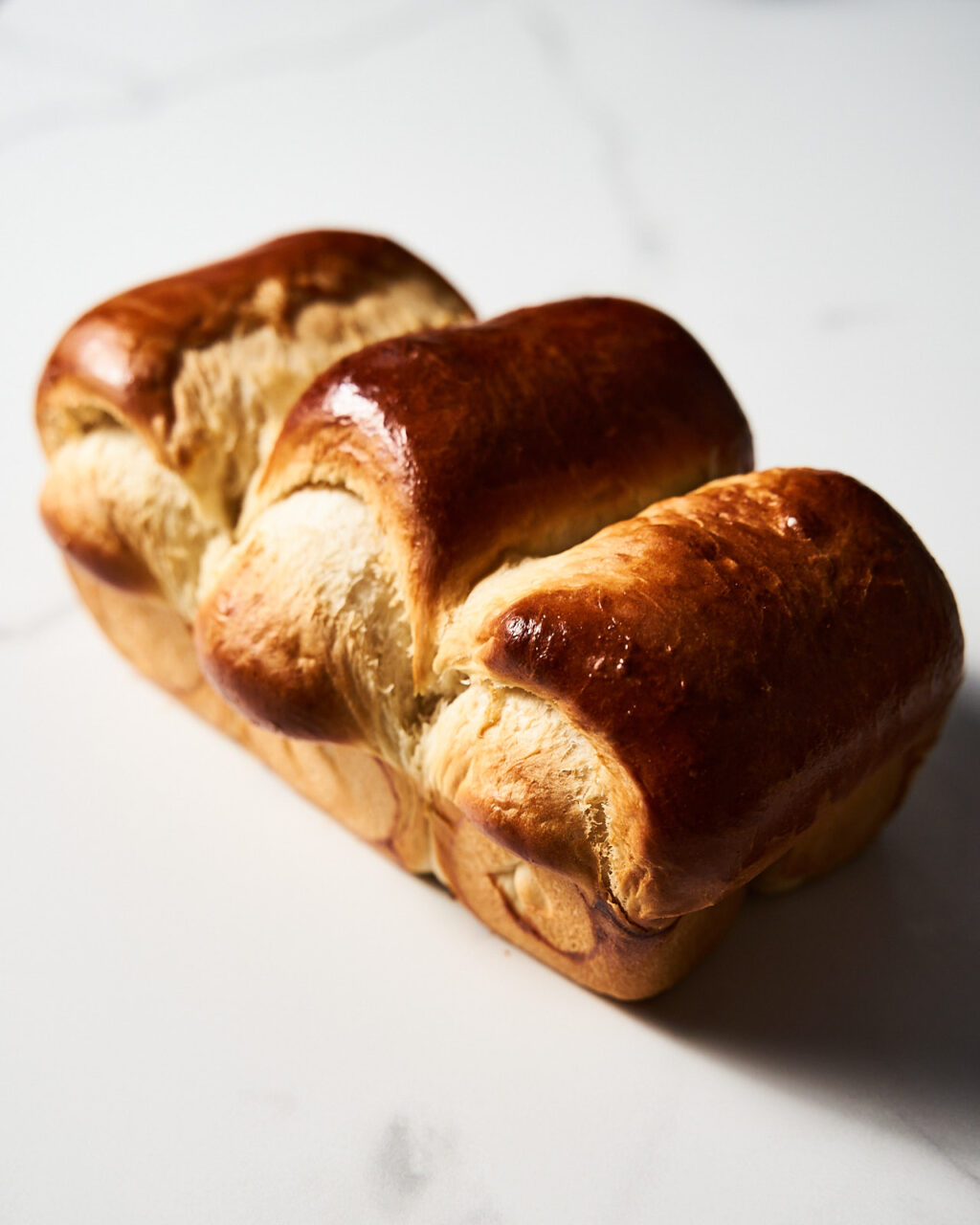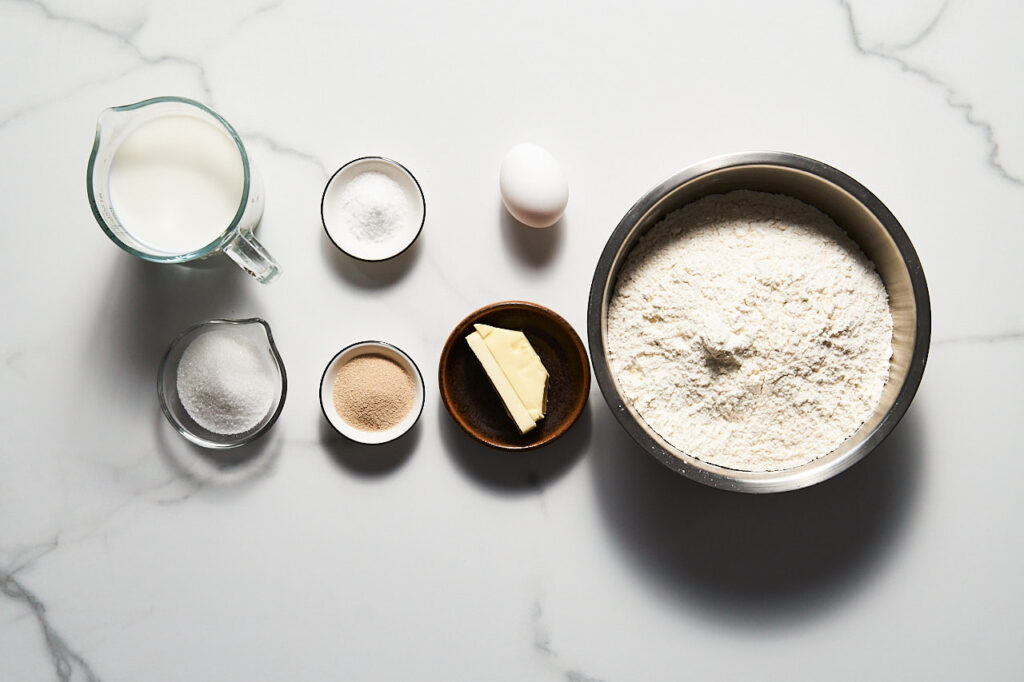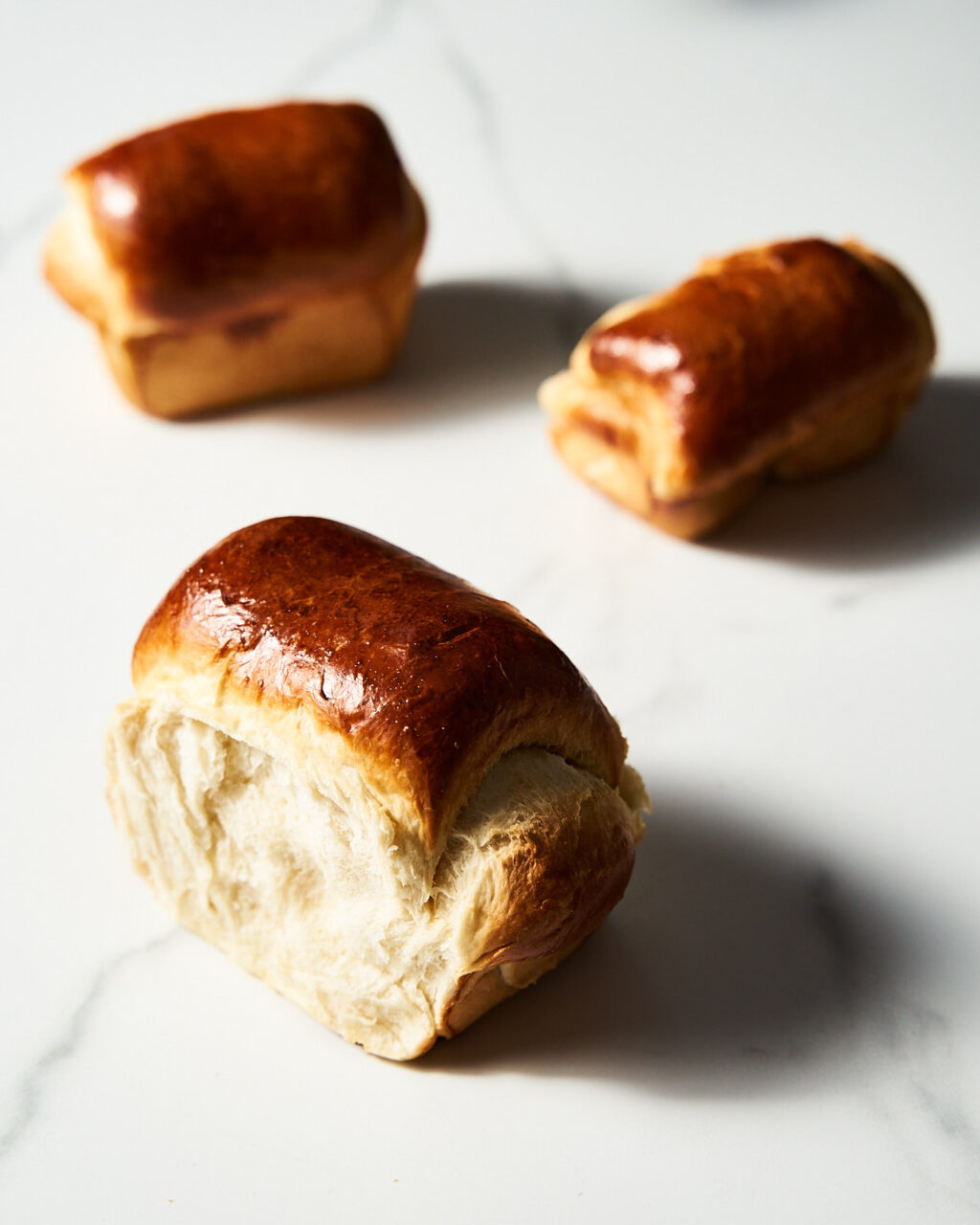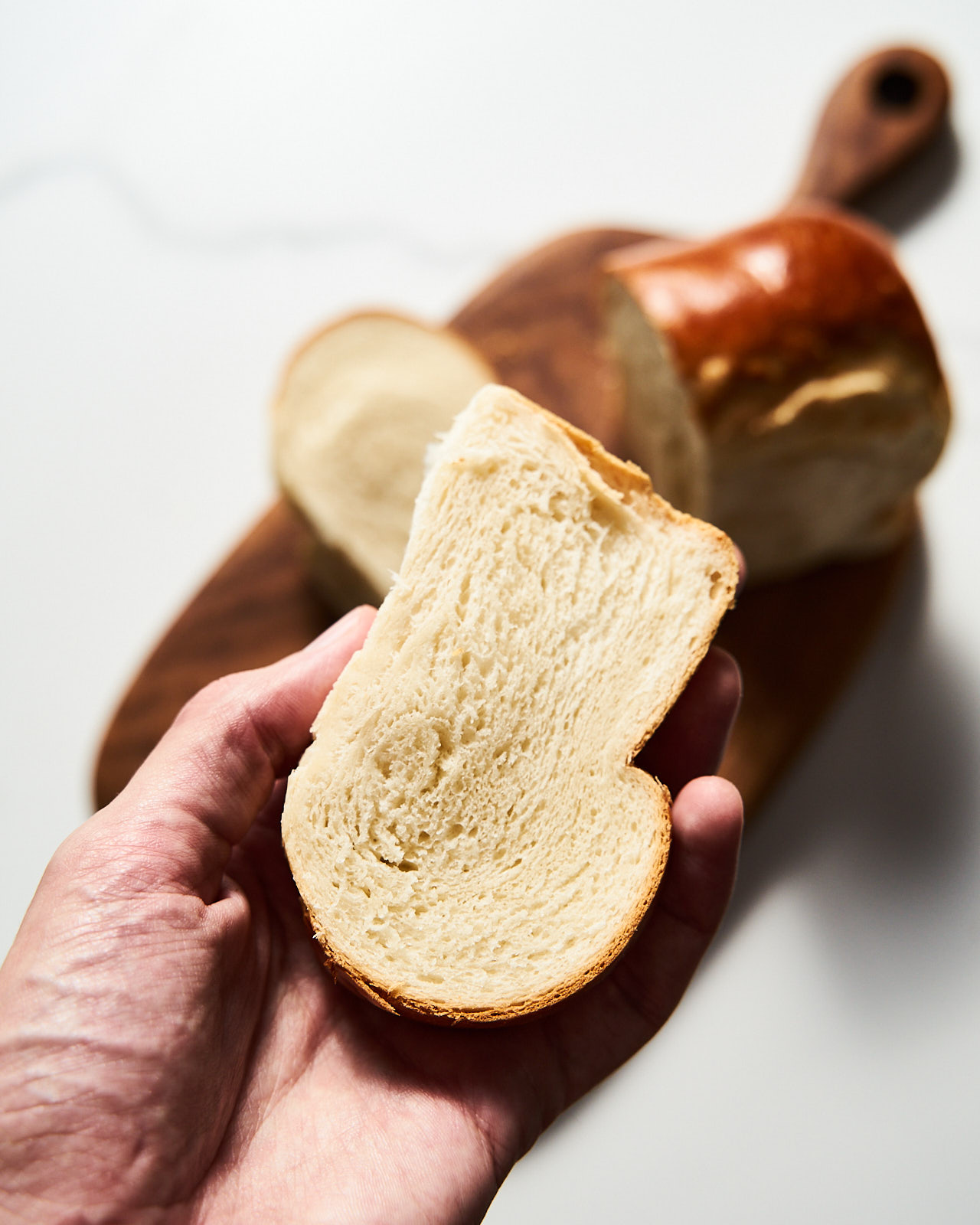Korean milk bread has an amazing softness and a subtle sweet flavor. Very tender, melt-in-your-mouth and so easy to prepare.
This bread can be eaten on its own, but it is a perfect complement to both sweet and savory dishes. Serve it over a hearty stew, simply spread it with butter and/or jam, or make coffee French toast with it.
This recipe can also be used to make lovely brioche-like buns.
Contents

⏱ Cooking time — 3 hours and 40 minutes overall. Includes 40 minutes of preparation and cooking + 3 hours unattended.
🔪 Ingredients
For 1 bread:
- 600 g (1 ⅓ lb) all-purpose flour
- 50 g (1 ¾ oz or ≈ 10 tsp.) granulated sugar
- 10 g (⅓ oz or 2 tsp.) salt
- 50 g (1 ¾ oz or 2 tbsp.) unsalted butter
- 240 ml (1 cup) milk
- 120 ml (8 ⅛ tbsp.) water
- 10 g (⅓ oz) instant yeast
- 1 egg for greasing
*for a tall bread mold, for my low mold I had to adjust the amount of dough slightly, reducing the weight of the ingredients by 25%.

🥣 Directions
👉 Jump to Short Version of RecipePreparation of the liquid mixture
Heat 240 ml (1 cup) of milk in a small saucepan to about 45 °C (slightly warm, not hot to the touch).
Add 10 g salt (⅓ oz or 2 tsp.), 50 g (1 ¾ oz or ≈ 10 tsp.) sugar, and 50 g (1 ¾ oz or 2 tbsp.) butter to the milk. Stir until the sugar has dissolved and the butter has melted.
Kneading the dough
Combine 600 g (1 ⅓ lb) flour and 10 g yeast in a large bowl and mix with a whisk.
Pour in a third of the liquid mixture and start kneading the dough.
Add the remaining liquid, and knead the dough for about 10 minutes by hand, or about 5-7 minutes with a planetary mixer, until smooth.
Transfer the dough to a work surface and form it into a ball. Place it in a clean bowl, cover, and leave it in a warm place for 2 hours.
Shaping the buns
After 2 hours, pierce the dough with your fingers to allow air to escape and transfer it to a work surface.
Shape the dough into a ball again, then roll into a bundle and divide into 3 equal portions. Take one part of the dough and cover the rest with clingfilm to prevent it from getting weathered.
Form the dough into a ball, then press down and roll out with a rolling pin into an oval. Fold the long sides of the dough inwards so that they meet in the center and press lightly with your fingers. Twist the dough on the short side into a roll and seal the bottom edge. Place in the mold seam side down, prepare the remaining dough in the same way.
To make the rolls: divide the dough into 6 pieces, roll each into a ball, transfer to a baking tray some distance apart and follow all other bread making instructions.
Cover the mold with 3 pieces with foil and leave to proof for 20-25 minutes.
Baking bread
Beat the egg with a fork.
Brush the top of the future bread with egg and place in the oven. Bake at 180 °C (350 °F) for 25-28 minutes.
Take the bread out of the oven and help it to separate from the mold using a knife, then remove it from the mold and place it on a wire rack to cool.
It is important to take the bread out of the mold at once so that it does not get soggy.
When the bread has cooled completely, it is ready.

🙋♂️ FAQ
Can I use all-purpose flour instead of bread flour for this recipe?
Yes, all-purpose flour can be used, but bread flour is preferred for its higher protein content, which contributes to the bread’s soft and fluffy texture.
Can I knead the dough by hand if I don’t have a mixer?
Yes, you can knead the dough by hand. It might take a little longer, around 10-15 minutes, to achieve the same smooth and elastic consistency.
What can I use if I don’t have a bread loaf pan?
If you don’t have a bread loaf pan, you can shape the dough into individual buns and bake them on a lined baking tray with enough space between each for expansion.
Can I make this bread without eggs for a vegan version?
For a vegan version, omit the egg used for glazing. You can brush the top with plant-based milk or melted vegan butter instead.
How can I tell if the bread is fully baked?
The bread is done when it has a golden-brown crust and sounds hollow when tapped at the bottom. An internal temperature of about 190°F (88°C) is also a good indicator.
Is it possible to add fillings to this bread, like chocolate or cheese?
Absolutely! You can incorporate fillings like chocolate chips or cheese into the dough before the final shaping and baking step.
Can I freeze this bread?
Yes, the bread freezes well. Wrap it tightly in plastic wrap and freeze for up to a month. Thaw at room temperature and reheat slightly before serving.
Can I use instant yeast instead of active dry yeast?
Yes, you can use instant yeast in the same quantity. Instant yeast doesn’t need to be activated in warm milk and can be mixed directly with the dry ingredients.
Why does my dough take longer to rise?
The rising time can vary based on the room temperature and yeast freshness. In colder environments, it may take longer for the dough to rise. Ensuring your yeast is not expired can also help.
How can I ensure my bread stays ultra-soft and fluffy?
Kneading the dough sufficiently to develop gluten and ensuring a proper first rise are key. Also, avoid over-baking, as it can dry out the bread.
Can I add sugar to the dough for a sweeter bread?
Yes, you can increase the sugar amount if you prefer a sweeter bread. However, too much sugar can affect yeast activity, so be cautious with the quantity.
Why is my bread crust too hard?
A hard crust can result from over-baking or baking at too high a temperature. Try reducing the oven temperature and check the bread a few minutes earlier than the prescribed time.
Can I use a different type of milk, like almond or soy milk?
Yes, you can use non-dairy milk like almond or soy milk, but the final flavor and texture might slightly vary from the original recipe.
How should I store the bread to maintain its freshness?
Store the bread in an airtight container or wrap it in plastic wrap at room temperature. Avoid refrigerating, as it can dry out the bread.
Is this bread suitable for making sandwiches?
Absolutely! Korean milk bread is excellent for sandwiches due to its soft, fluffy texture and subtle sweetness.
📌 Pin it!




Korean milk bread – ultra soft and fluffy buns

Ingredients
- 600 g flour
- 50 g sugar
- 10 g salt (2 tsp.)
- 50 g butter
- 240 ml milk
- 120 ml water
- 10 g quick yeast
- 1 egg for greasing
Instructions
- Heat the milk. Add the sugar, butter, and salt to it and stir until the sugar dissolves and the butter melts.
- Mix the flour and yeast. Gradually add a third of the liquid mixture and knead the dough. Allow the dough to rise for 2 hours.
- Dip the dough, divide into portions and form into flagons. Divide each bundle into 3 pieces and form into rolls. Leave the dough under cling film to rise for another 20-25 minutes.
- Beat the egg with a fork and brush the top of the loaves with it. Bake in the oven at 180 °C (350 °F) for 25-28 minutes. Take the bread out of the oven and help it to separate from the mold, remove it from the mold and place it on a wire rack to cool before serving.
